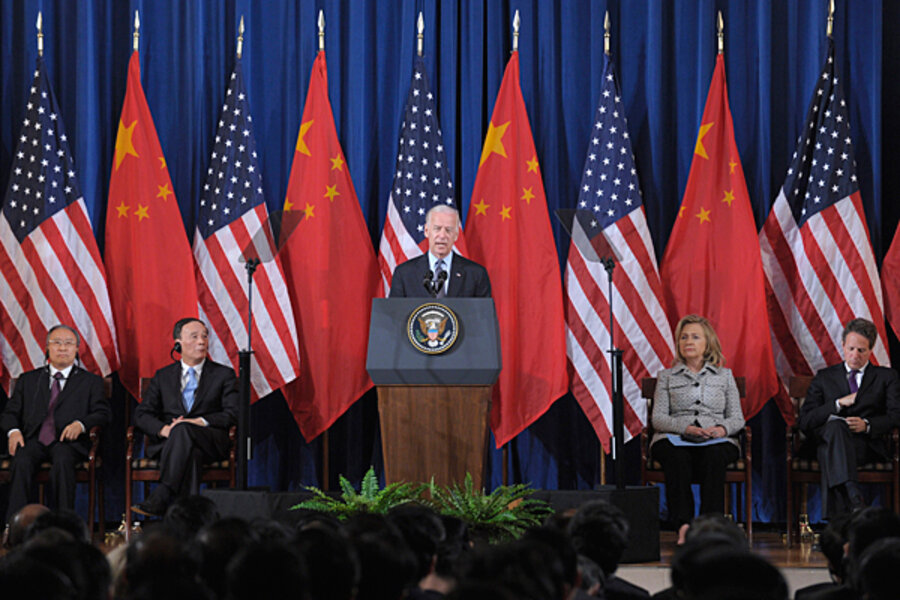US-China meeting comes as China faces its own problems, too
Loading...
A common refrain about the world's leading economic powers is that the US is sagging – overly indebted and maybe even in decline – while China's continuing rise is unstoppable.
There are elements of truth to that theme, but as top officials from the US and China confer on their bilateral relations this week, it's also misleading.
America is no economic basket case. Its problems are real but not unsolvable. And China, for all its progress and potential, confronts some significant challenges of its own. For leaders in Beijing, those problems include tamping down high inflation, generating more growth in the domestic economy (as opposed to exports), and coping with rapid aging of its population.
"In this decade, China needs to address challenges like crony capitalism, aging population,... and environmental degradation," economists at Bank of America Merrill Lynch wrote in a forecast earlier this year. "China also needs to adjust to its new role as a global power."
Those aren't easy problems to address, and these issues are important context for understanding the meetings this week in Washington.
Set aside the cartoon caricatures, like the online animation that showed Chinese President Hu Jintao measuring the drapes in the Oval Office. The talks aren't all about a weakling US trying to placate the powerful landlord from Beijing.
Rather, this is about two important and powerful nations that have some differences, some common ground, and a long-term interest in having strong working relations between their governments.
A more nuanced story line
To be sure, in a future of stepped up competition from China and others, America appears unlikely to retain the kind of preeminence it has enjoyed in the global economy for much of the time since World War II. But the US still has considerable strengths, from world-leading universities to a well-honed tradition of entrepreneurship and innovation by businesses.
China, for its part, has been advancing steadily in recent years, but there is ongoing debate about whether its development will be rocked by disruption, such as a bursting real estate bubble, at some point. The economists at Bank of America Merrill Lynch say that after double-digit economic growth and low inflation during the pre-crisis period of 2003 to 2007, China’s gross domestic product will grow a bit less than 10 percent this year. Inflation could rise to 4.5 percent.
"This pattern of lower growth and higher inflation could extend into the coming years and become a 'new normal,' driven mainly by changing demographics," write the economists, Ting Lu, T. J. Bond, and Xiaojia Zhi.
Inflation in China might have some positive effects for both nations, the economists argue. Rising prices could undercut the attractiveness of Chinese imports, helping to reduce trade imbalances with the US. But if higher prices are matched by rising wages in China, the result could also be that China drives more of its growth from internal demand, as consumers have more money to spend.
If things go well for China, it could surpass the US as the world's largest economy by 2020. If that occurs, China still wouldn't match US living standards, since China's national income would be spread among roughly four times as many people. But it speaks to some of the underlying truths of the standard US-China narrative, some of which will be at issue this week.
On the agenda
For one, China is an important US creditor and wants to make sure the US Treasury remains good for its debts. In all, nearly half of all US Treasury debt is owned by entities outside the US. And of the $4.5 trillion in US debt that is held abroad, China owns about one-fourth of the total.
And it's true that the US has challenges from rising government debt and global competition for jobs. In opening public remarks at the summit Monday, Treasury Secretary Tim Geithner pledged that the US is "working very hard to repair the damage caused by the financial crisis, to reform our financial system, and to restore fiscal sustainability."
Some economists say that, in addition to getting its own fiscal house in order, the US should press China harder for concessions on controversial trade practices.
On this front, Secretary Geithner said key US goals in the dialogue include pressing China toward greater flexibility in its foreign-exchange rate, continued progress toward protecting intellectual property rights, "and the promotion of technological innovation without discrimination against foreign firms."





